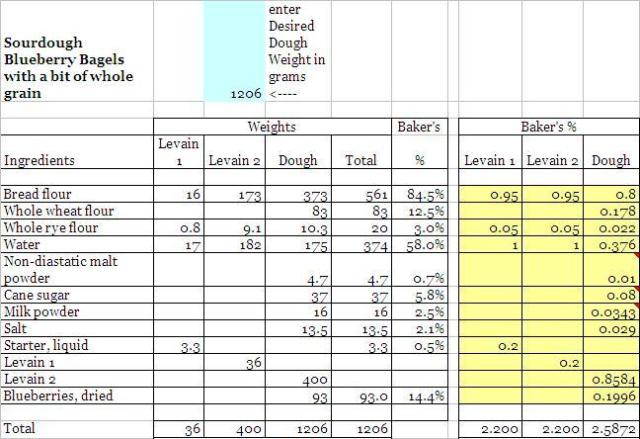Hello,
lumos made the most beautiful sourdough wholemeal bagels, and then I saw Susan's amazing-looking bagels, with the addition of dried blueberries; Eric wrote recently about his bagel journey, and the bagels he made looked really great too; the combination of flours he was using sounded interesting and I liked how he hand-mixed his bagel dough.
I decided to give sourdough bagels a try, using Susan's quantity of sourdough levain and no commercial yeast, whole wheat and some other ingredients like lumos used, the addition of some rye flour and mixing as both lumos and Eric suggested, and baking according to Mr. Reinhart's instruction in BBA.
Thanks to all for their formulas, ideas and instruction, so helpful to me for this bake!
My bagel-shaping needs work but I am happy to practice so more yummy-tasting bagels like these continue to emerge from the oven! I wanted to try the shaping method lumos referred to in her post but it wasn't working out so well with dried blueberries in the dough.
I've never tasted a sourdough bagel before this morning; I just love how these taste; it was so nice to pull these out of the fridge, and with a quick boil and bake, have fresh bagels for breakfast :^)

sourdough bagels are really good! :^) 

Mix first levain; when mature, mix second levain; when this has matured, mix dough.
1. Combine dry ingredients in a large bowl.
2. Mix levain and water in a separate bowl and stir until levain is dissolved into the water.
3. Pour the levain mixture into the dry ingredients and mix with a dough whisk until dry ingredients are hydrated. Rest the dough, covered, for 15 minutes or so to let the flour absorb water.
4. Stretch and fold in the bowl (20 folds); let dough rest 1o minutes; knead on counter for 7 minutes.
Add dried blueberries and fold/knead to incorporate into dough.
Let dough sit in bowl on counter, covered, for one hour, with stretch and fold after 20, then 40 minutes.
The dough got to an 'improved' stage of development.
5. Divide the dough into 12 pieces of about 100 g each.
6. For shaping the bagels, I tried flattening each dough piece into a small rectangle, then rolling into a cylinder, then extending a bit. After this was done for all 12 pieces, starting with the first piece, I rolled each piece again to lengthen, overlapped the ends and rolled on the counter to seal and shape the bagel.
The dough had just enough tackiness so the ends stuck together easily, but not so much that the dough was sticking to my hands or the counter. I didn't have to use any additional flour when shaping these.
7. Place shaped bagels on a parchment-paper lined baking sheet. Cover the bagels, so the surface of the dough will not dry out during proofing and retarding.
Proof at room temperature until the bagels look like they've puffed up a bit.
My kitchen was cool, and after 1.5 hours at room temperature it didn't look like the bagels had proofed at all, so I moved them to a proof box at 78F, and proofed for another two hours.
8. Retard bagels in fridge overnight.
9. Preheat oven to 500F (no baking stone).
Prepare baking sheet(s) for baking by lining with new parchment paper, spraying lightly with oil, and sprinkling with semolina.
Add water to large, wide saucepan, add 1 Tablespoon barley malt syrup, and bring water to boil.
Add 1 Tablespoon baking soda to boiling water (contents in the pan may foam up).
Remove bagels from the fridge. With slotted spoon, place bagels top side down in boiling water. Place as many as will fit in one layer.
Boil 1 minute, turn top side up, boil 1 more minute.
With slotted spoon, lift from water, let excess water drip off, and place top side up on prepared baking sheet.
10. Bake bagels at 500F for 5 minutes. Rotate pan(s). Reduce oven temperature to 450F, and bake for 5 minutes, or possibly a bit longer until the bagels are browned to your liking.
Remove to cooling rack to cool.
Happy baking everyone,
:^) from breadsong
Sending, with gratitude, to Susan @ YeastSpotting